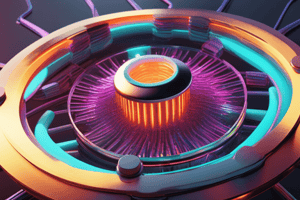Podcast
Questions and Answers
What is the property of matter that causes electrostatic force between materials?
What is the property of matter that causes electrostatic force between materials?
Electric charge
Explain the concept of quantization of charge.
Explain the concept of quantization of charge.
Charge is always transferred in fixed packets or multiples.
How can charging be done without direct contact between materials?
How can charging be done without direct contact between materials?
Charging by induction
What does Coulomb's law calculate in the context of charges?
What does Coulomb's law calculate in the context of charges?
Why is understanding vector quantities essential when calculating the force between charges?
Why is understanding vector quantities essential when calculating the force between charges?
What do electric field lines represent and what do they show?
What do electric field lines represent and what do they show?
Describe the property of electric field lines in relation to metal surfaces.
Describe the property of electric field lines in relation to metal surfaces.
Can electric field lines intersect to create closed loops? Why or why not?
Can electric field lines intersect to create closed loops? Why or why not?
What is a dipole and what does it consist of?
What is a dipole and what does it consist of?
What is the formula for the electric field due to a point charge?
What is the formula for the electric field due to a point charge?
Flashcards are hidden until you start studying
Study Notes
- The video is about a quick revision of the chapter on electric charge in physics for class 12 students.
- Electric charge is a property of matter that causes electrostatic force between materials.
- Charges can be negative (extra electrons) or positive (lack of electrons).
- Neutrons have no charge and are considered neutral.
- Charging can be done by conduction (contact) or induction (without contact).
- Friction results in transferring electrons between bodies, causing one to become charged.
- Charging by induction involves attracting or repelling electrons without direct contact.
- Quantization of charge means charge is always transferred in fixed packets or multiples.
- Conservation of charge states that total charge in a system remains constant.
- Coulomb's law calculates the force between charges, with the formula F = k * (q1*q2) / r^2.
- Permittivity of free space defines the value of the constant k in Coulomb's law.- The text discusses the concept of vector form in Coulomb's law and the importance of direction when dealing with vectors.
- It explains how to determine the direction of force between charges q1 and q2 by using the concept of vectors.
- The text delves into the calculation of force between charges and emphasizes the necessity of understanding vector quantities.
- It touches upon the calculation of electric field lines and their properties, including their direction in relation to positive and negative charges.
- The text explains the concept of electric field lines being imaginary lines that show the direction of the force on a positive charge placed in the field.
- It discusses the properties of electric field lines, including their smooth and continuous curves from positive to negative charges.
- The text elaborates on the property of electric field lines being perpendicular on metal surfaces and never intersecting to create closed loops.
- It explains how any charge placed in an electric field experiences a force, and the formula for calculating the force in an electric field.
- The text introduces the concept of a dipole, which consists of equal and opposite charges, and explains the dipole moment formula.
- It mentions the importance of understanding the strength of a dipole and calculating the dipole moment based on the magnitude of charges and the distance between them.
- The text delves into the concept of electric field due to a single charge, known as the electric field due to a point charge, with the formula E = kq / r².
Studying That Suits You
Use AI to generate personalized quizzes and flashcards to suit your learning preferences.




